Imagine stepping into your backyard and being greeted by a charming dining oasis that feels like an extension of your home. Whether you’re a seasoned outdoor aficionado or a novice looking to spruce up your space, “10 Outdoor Dining Ideas for Your Next Project” promises to inspire and guide you. With a dash of creativity and practical tips, you’ll soon discover how to turn any outdoor area into a delightful dining retreat.
In this guide, each idea is crafted to enhance your outdoor living experience, making meals under the sun or stars a cherished ritual. From cozy nooks to grand gatherings, you’ll find designs that maximize comfort and style while being perfectly tailored to your skill level. Get ready to transform your backyard into a beautiful haven and feel empowered to host memorable moments right at home!
Select Durable, Weatherproof Furniture
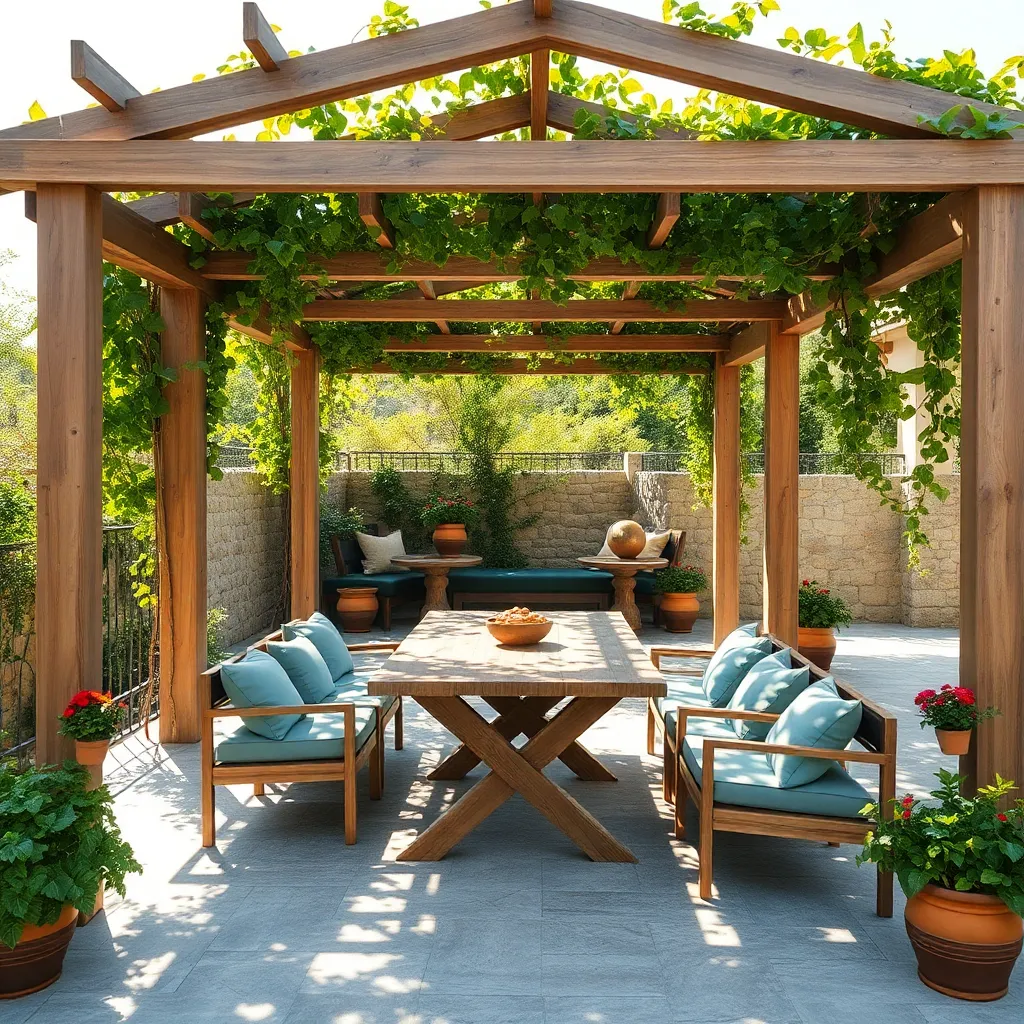
When selecting furniture for your outdoor dining area, prioritize durability and weather resistance to ensure longevity and minimal maintenance. Materials like teak, eucalyptus, and powder-coated aluminum are excellent choices as they withstand various weather conditions while retaining their aesthetic appeal. For those seeking a more advanced approach, consider incorporating furniture with UV-resistant finishes or water-repellent cushions to further safeguard against the elements.
To create a cohesive and inviting space, focus on furniture that complements both your outdoor shelter style and the overall landscape. Opt for pieces with clean lines and neutral tones for a modern look, or explore rustic designs with natural wood finishes for a more traditional feel.
- Ensure tables and chairs are appropriately sized to the space, typically allowing at least 24 inches of width per seat for comfort.
- Include a mix of fixed and adjustable pieces to adapt to different occasions and group sizes.
By choosing versatile, weatherproof pieces, you can enjoy your outdoor dining setup year-round with confidence and ease.
Incorporate Built-In Outdoor Heating
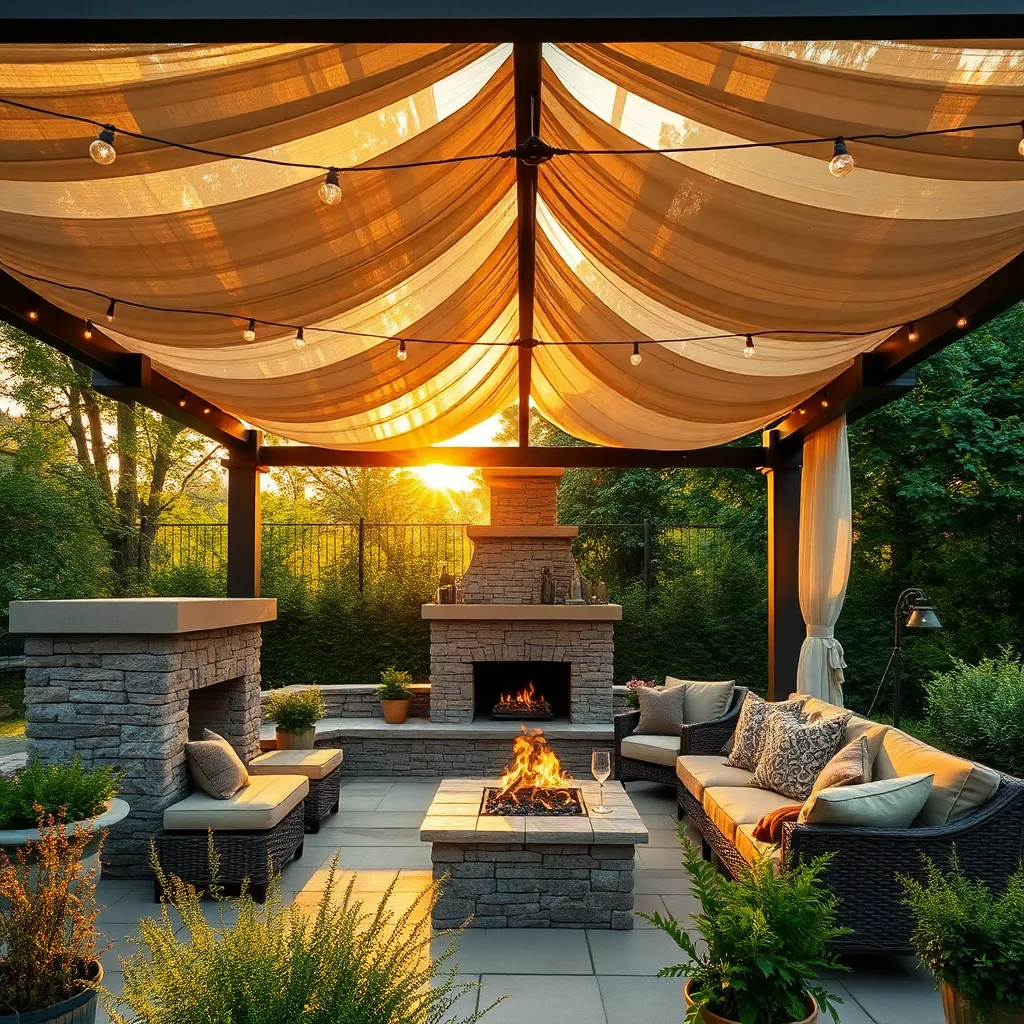
Enhancing your outdoor dining space with built-in heating is a smart way to extend its usability into cooler months. Consider integrating infrared heaters, which are efficient and provide immediate warmth. These can be mounted to walls or ceilings for a seamless look that doesn’t take up floor space. For a more rustic ambiance, built-in fire pits using materials like stone or metal can serve as both a heat source and a captivating centerpiece. Remember to choose weather-resistant finishes to ensure longevity.
For those looking to add a touch of sophistication, underfloor heating systems can be installed beneath stone or tile flooring, providing subtle warmth without visible equipment. Ensure that any electrical components are rated for outdoor use and consult with a professional for installation to ensure safety and efficiency. Additionally, consider the placement of your heat sources to maximize comfort; positioning heaters around seating areas will ensure even warmth distribution. With these options, you can create a cozy, inviting atmosphere that encourages year-round outdoor dining.
Utilize Pergolas for Shade Control
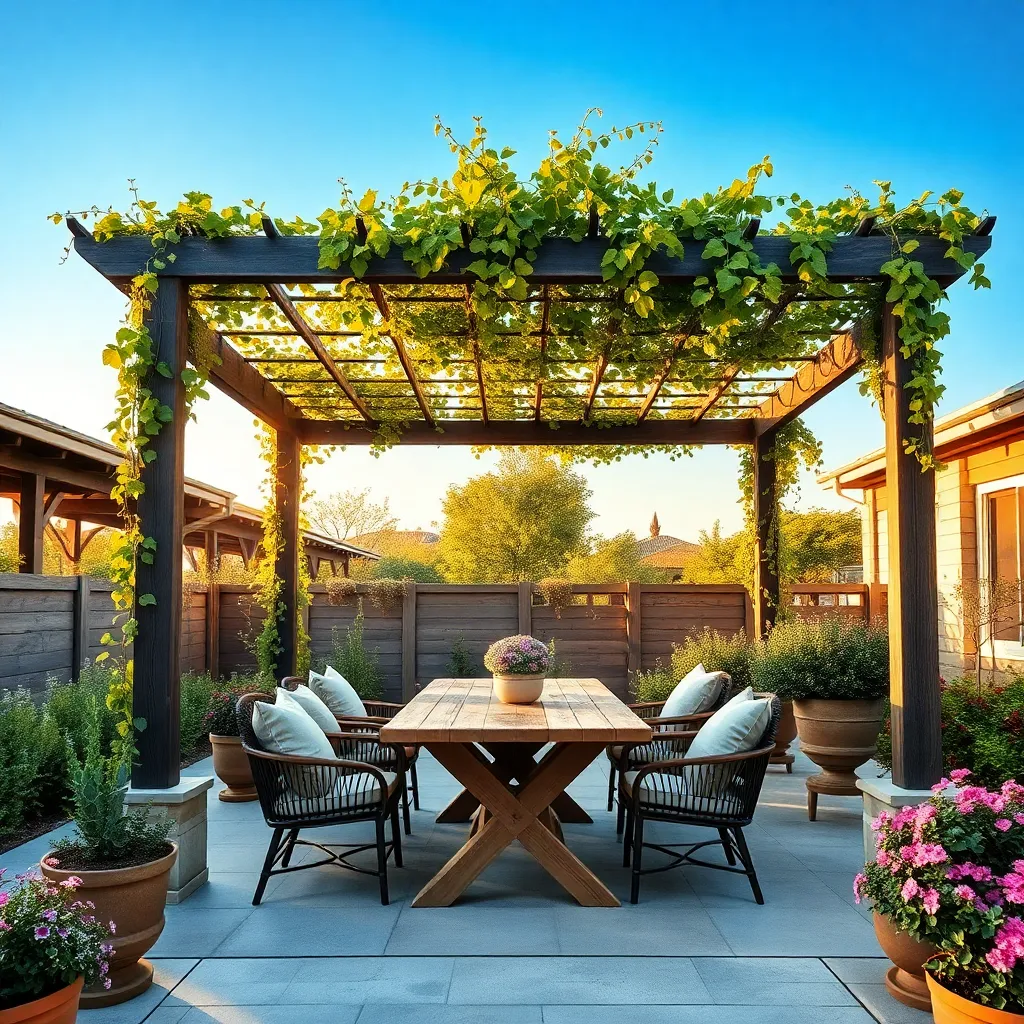
Pergolas are an excellent choice for controlling shade in your outdoor dining area, offering both functionality and style. To create an effective pergola, consider using durable materials like cedar, redwood, or aluminum, which resist weathering and require minimal maintenance. Beginners can start with a basic square or rectangular design, while more experienced DIYers might explore lattice roofs or adjustable louvers to fine-tune the amount of sunlight filtering through.
Enhance your pergola with climbers like wisteria or grapevines for natural shade and visual appeal. For a more advanced touch, incorporate retractable canopies or fabric panels, allowing you to adjust the coverage based on the time of day or season. Ensure your pergola is structurally sound by anchoring it securely, especially in regions prone to high winds. This versatile addition can transform your outdoor dining area into a comfortable and inviting space for family and friends.
Add Ambient String Lighting
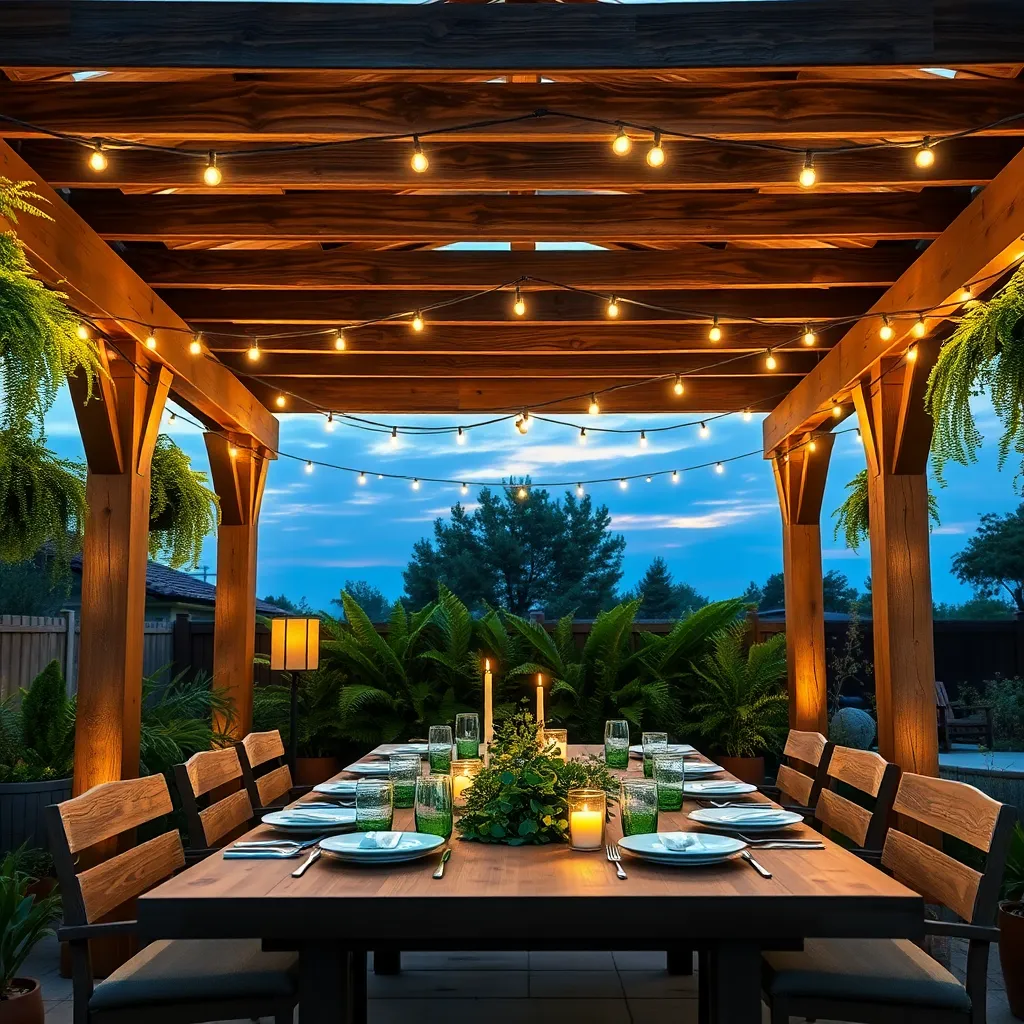
Adding ambient string lighting can transform your outdoor dining area into a warm and inviting space. Start by selecting weather-resistant string lights, such as those with LED bulbs encased in shatterproof plastic, which are both durable and energy-efficient. Choose between classic white lights for a timeless look or colored bulbs for a more festive atmosphere. To achieve a seamless installation, consider using hooks or clips to drape the lights across existing structures like pergolas, trees, or along fences, ensuring an even distribution of light.
For a more customized setup, plan the lighting layout to highlight specific areas, like the dining table or a cozy seating nook. Measure the dimensions of your space to determine the length of string lights needed, ensuring you have enough to create the desired effect without overloading your power source. Pairing string lights with dimmer switches can also offer flexibility to adjust the mood as the evening progresses. By layering your lighting, you can enhance both the functionality and the ambiance of your outdoor dining area, making it a perfect setting for evening gatherings.
Use Retractable Awnings for Flexibility
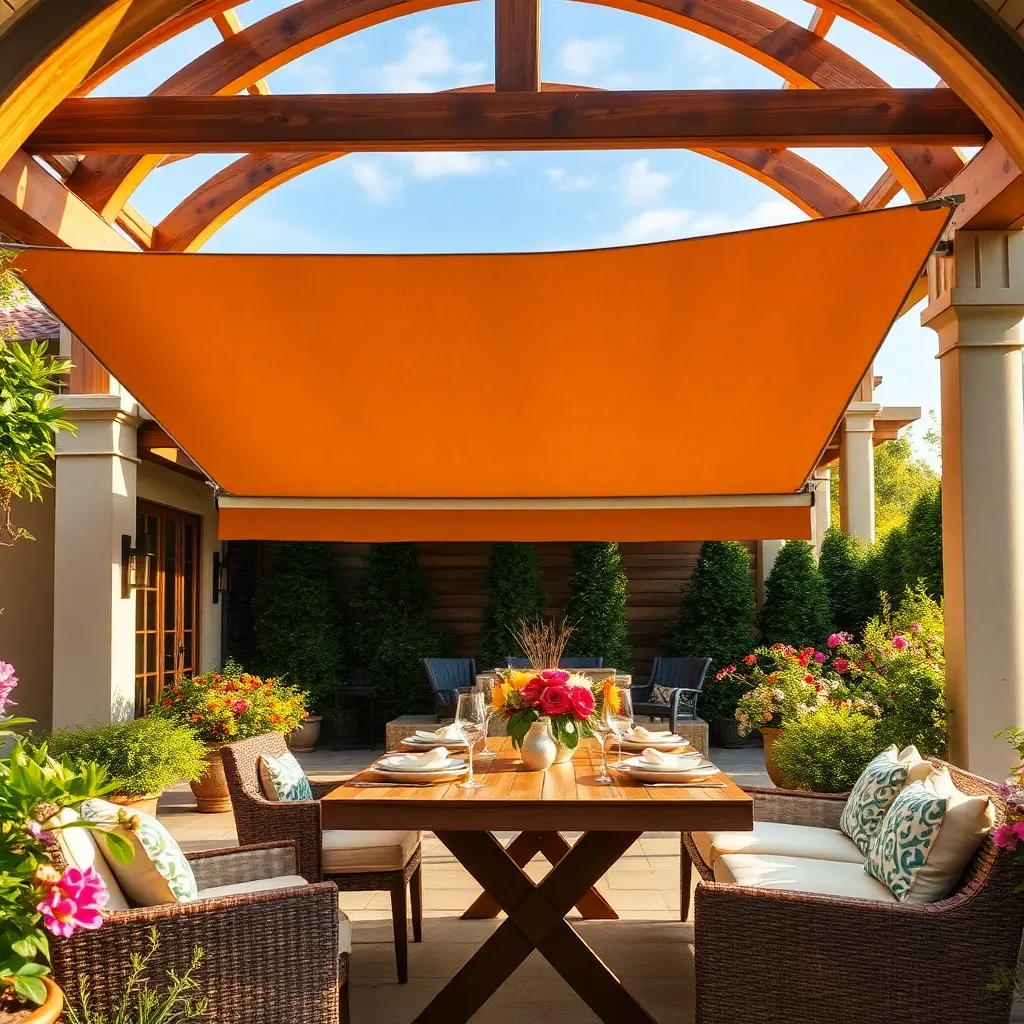
For those seeking flexibility in their outdoor dining setups, retractable awnings offer an excellent solution. These versatile structures allow you to easily adjust the amount of shade or sun, enhancing comfort regardless of the weather. When choosing a retractable awning, consider materials like durable acrylic fabrics that resist fading and mildew, ensuring long-lasting performance. Additionally, motorized options provide convenient operation, while manual models offer a cost-effective alternative.
Installation is key to maximizing the benefits of your retractable awning. Ensure the mechanism is securely mounted to a stable surface—such as a wall or pergola beam—to provide robust support. Consider the dimensions of your outdoor space; common awning widths range from 10 to 20 feet, with projections up to 13 feet. For those with larger patios, linking multiple awnings can provide expansive coverage. With these tips, you can create a dynamic outdoor dining area that adapitates to your needs year-round.
Incorporate Nature with Vertical Gardens
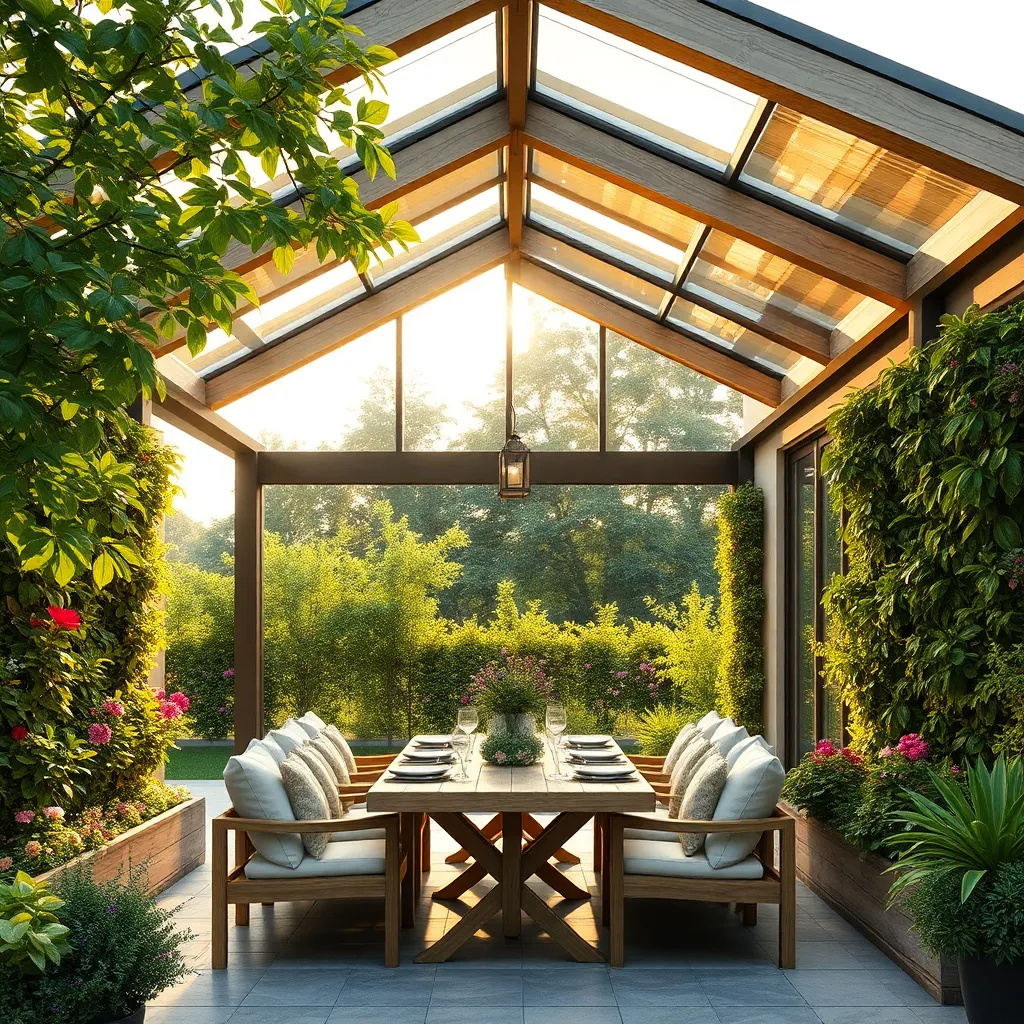
Bringing nature into your outdoor dining area can be as simple as incorporating vertical gardens. These gardens are perfect for maximizing space, especially in smaller yards or patios, and can be created using a variety of structures such as trellises or wall planters. For beginners, start with a simple wooden trellis or a modular wall planter system that can be easily attached to your outdoor wall. Opt for durable materials like cedar or pressure-treated wood to withstand weather elements and ensure longevity.
For a more advanced take, consider installing a living wall system with integrated irrigation, which ensures your plants get consistent moisture. Choose a mix of herbs, flowers, and trailing plants like ivy or ferns to add both beauty and functionality—imagine having fresh basil right at your fingertips as you dine outdoors. Ensure your structure can support the weight of mature plants by using sturdy brackets and anchors. This combination of style and practicality not only enhances the ambiance but also contributes to a sustainable and lush environment for your outdoor dining experience.
Opt for Multifunctional Dining Tables
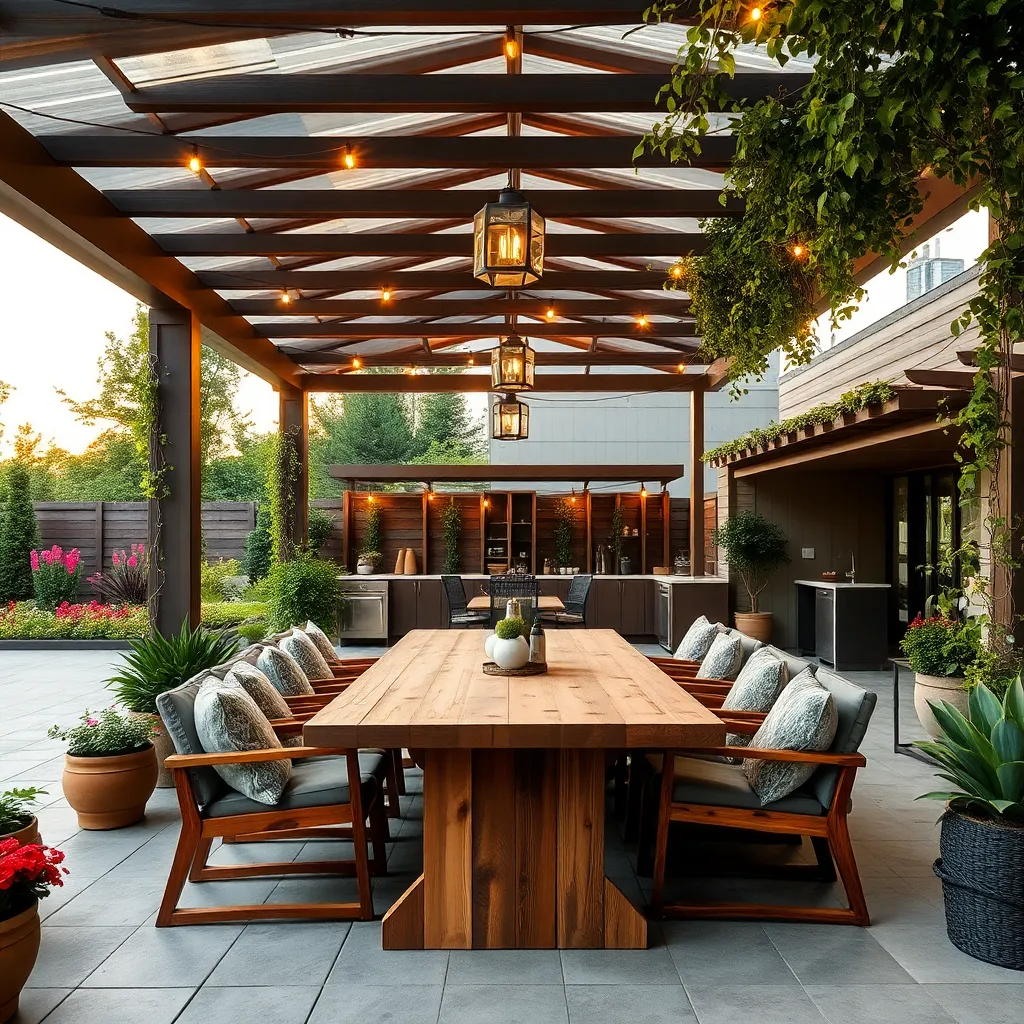
When selecting a dining table for your outdoor space, consider opting for multifunctional designs that can adapt to various needs. Look for tables with adjustable heights or extendable leaves, which allow you to accommodate more guests without compromising on space. Materials like treated wood, powder-coated metal, or weather-resistant wicker ensure durability while maintaining aesthetic appeal. Beginners should focus on tables that are easy to maintain, while experienced homeowners might explore custom-built options that integrate storage or even a built-in cooler.
For those looking to blend functionality with style, choose tables that feature integrated seating or hidden compartments for storing outdoor essentials. Consider incorporating features like foldable sides or benches that tuck under the table, optimizing your outdoor area without clutter. Pay attention to dimensions; a table size of about 6 to 8 feet long can comfortably seat six people, which is ideal for most setups. Advanced gardeners can take it a step further by designing tables with built-in planters or herb gardens, adding a lush touch to your dining experience.
Include Cozy Outdoor Cushions
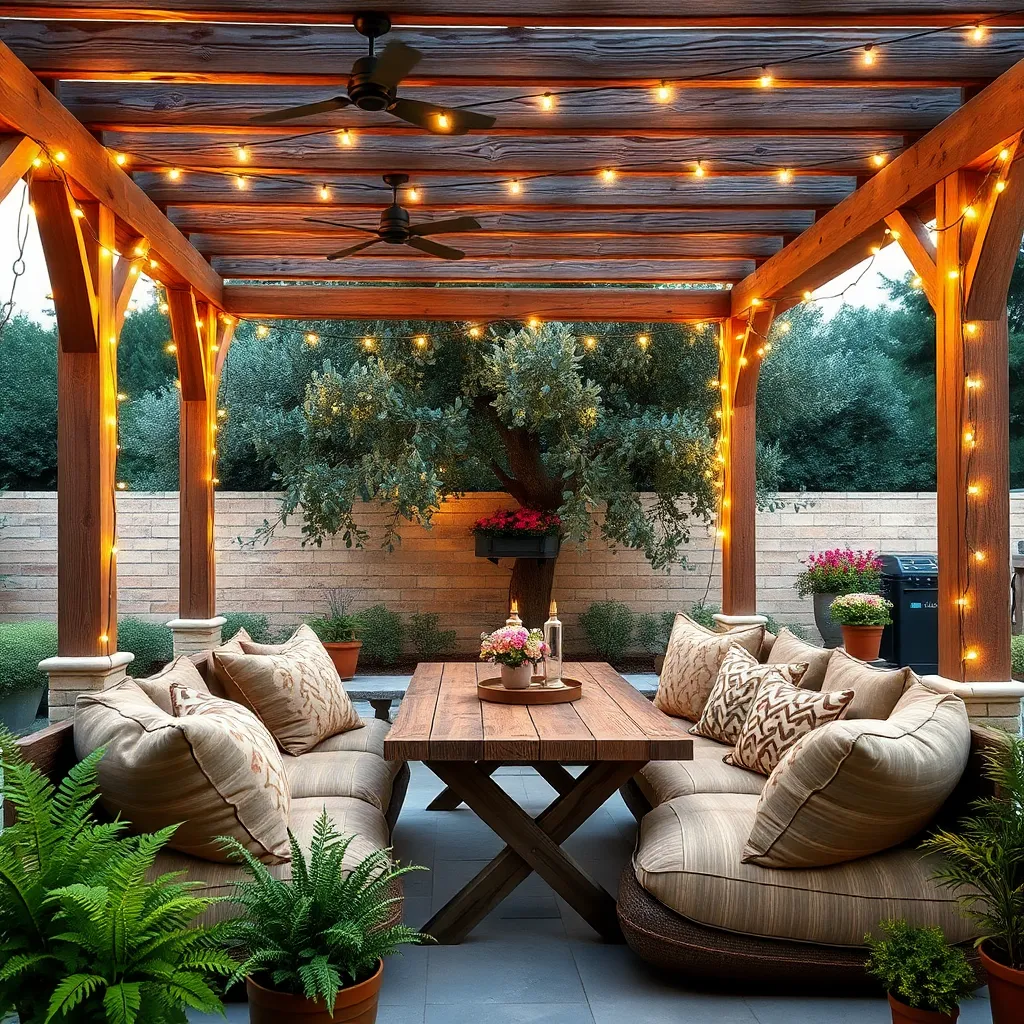
Transform your outdoor dining area into a cozy retreat by incorporating plush cushions on your seating. Opt for weather-resistant materials such as acrylic, polyester, or olefin fabrics that can withstand the elements and resist fading. For a pop of color, choose vibrant cushion covers that complement your dining setup, and consider using a mix of patterns and solid colors to add visual interest. Investing in high-density foam will ensure that your cushions remain comfortable and supportive over time.
Enhance the comfort and aesthetics of your space by selecting cushions with high-quality stitching and reinforced seams. Consider removable covers for easy cleaning and maintenance, and integrate ties or Velcro straps to keep cushions securely in place during windy days. For those looking to add a touch of luxury, include cushions with piping for a polished finish, or layer different sizes and shapes to create depth and dimension. This approach not only elevates your dining experience but also extends your living space into the great outdoors.
Choose Eco-Friendly Dining Ware
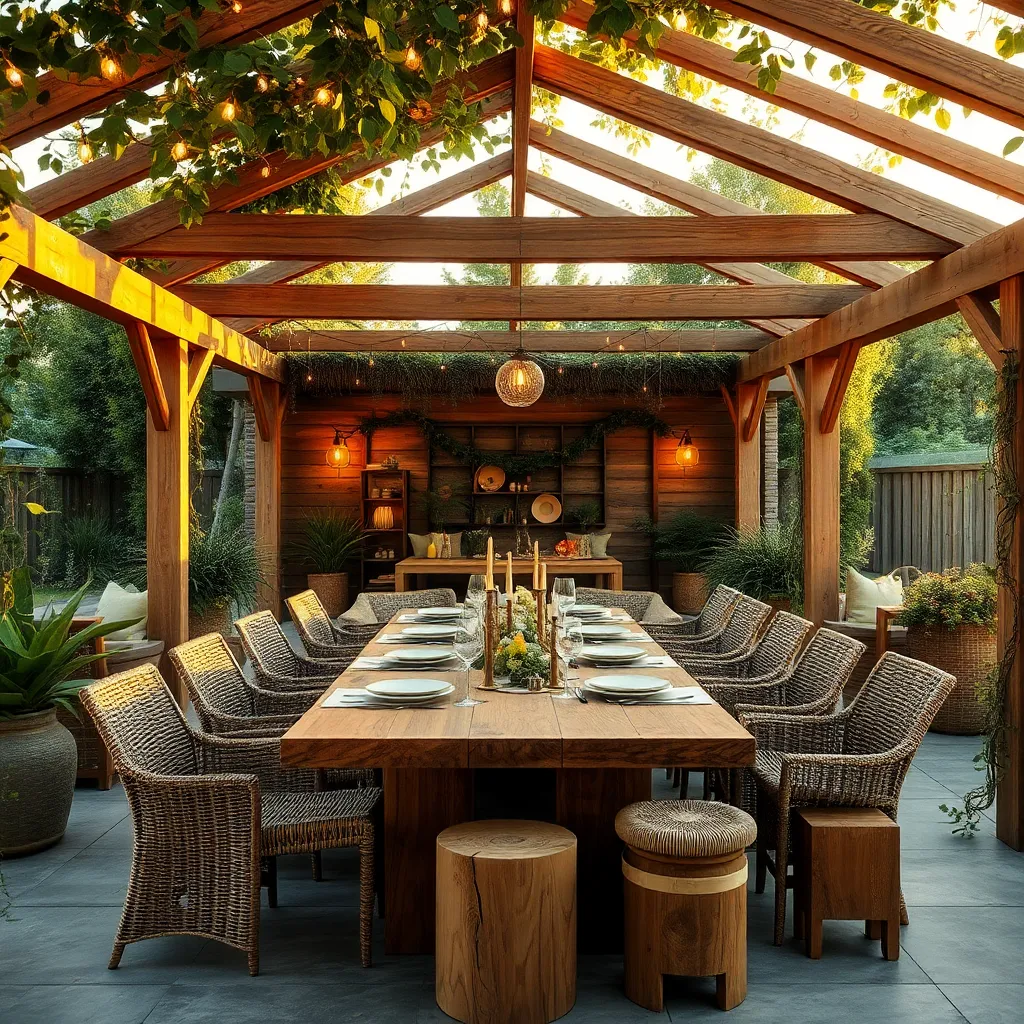
For a more sustainable outdoor dining experience, consider using eco-friendly dining ware made from materials like bamboo, palm leaf, or recycled glass. These options not only minimize environmental impact but also add a unique aesthetic to your outdoor gatherings. Bamboo, for example, is lightweight and durable, making it a perfect choice for casual alfresco meals. Beginners can start with a basic set of bamboo plates and cutlery, while those looking to elevate their setup can explore artisan-crafted recycled glassware.
Another practical tip is to choose dining ware that is biodegradable or compostable, thereby reducing waste and contributing to a healthier planet. Look for products certified by reputable eco-labels to ensure they meet environmental standards. For a cohesive look, consider matching your dining ware with natural textiles like linen or cotton napkins, which can be easily washed and reused. Advanced gardeners might explore setting up a small composting area nearby, turning used biodegradable items into nutrient-rich soil for your garden.
Design with Windbreaks for Comfort
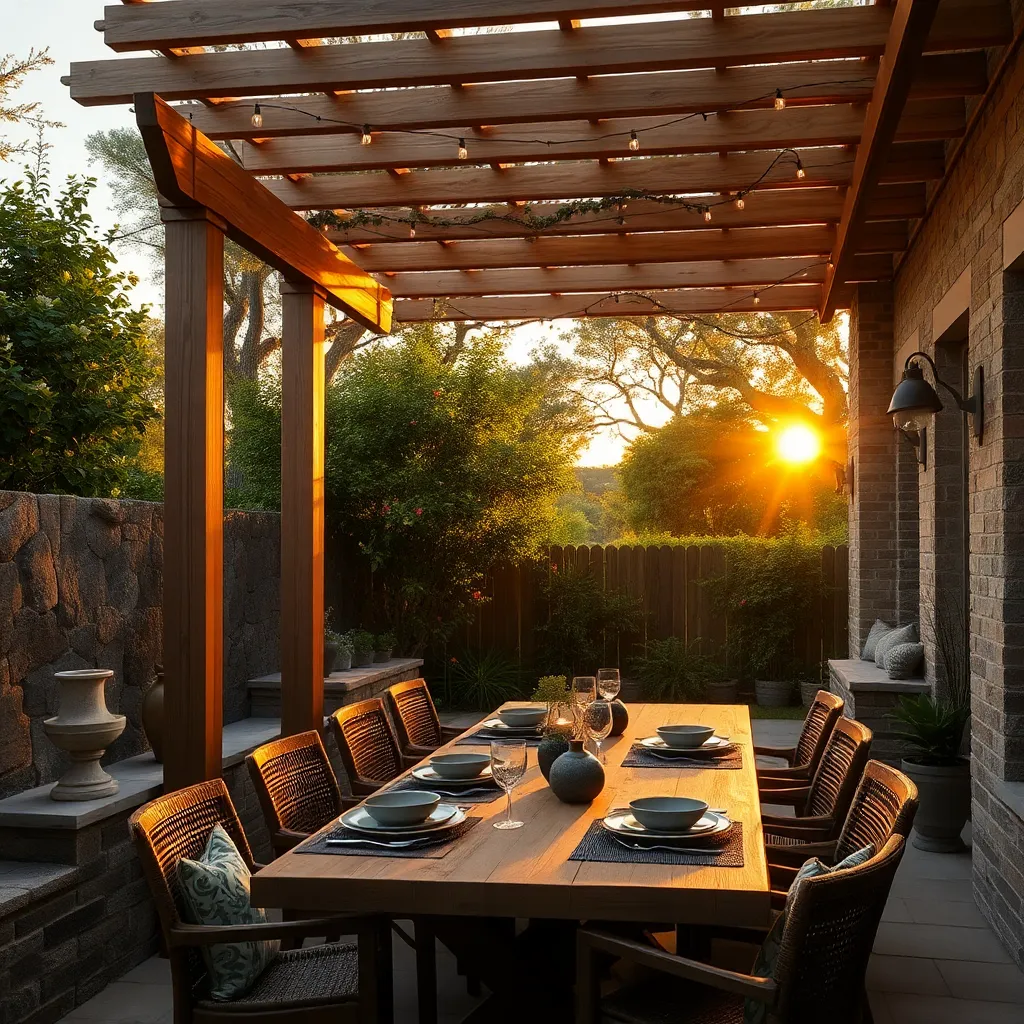
Creating a comfortable outdoor dining area involves more than just a table and chairs—consider incorporating windbreaks to shield guests from gusty breezes. Start with versatile options like hedges or bamboo screens, which can be both functional and aesthetically pleasing. For beginners, planting a row of fast-growing shrubs such as arborvitae or privet can offer quick coverage and a natural look. If you’re looking for a more advanced project, consider building a wooden lattice or trellis, which can double as a support for climbing plants, enhancing both protection and ambiance.
Consider the prevailing wind direction when planning your windbreak to ensure maximum effectiveness. A well-designed barrier should be placed at an angle to the wind, ideally at a distance of around ten times its height for optimal coverage. Materials such as sturdy, weather-resistant fabrics can be used for temporary screens, providing flexibility for seasonal changes. For a more permanent solution, stone walls or fences made from treated wood can offer a robust and stylish option. No matter your choice, incorporating windbreaks will enhance comfort and extend the usability of your outdoor dining space throughout the year.
Conclusion: Creating Beautiful Outdoor Spaces
As we explored the ’10 Outdoor Dining Ideas for Your Next Project,’ we unveiled a diverse array of relationship-enhancing concepts. From the intimate coziness of a backyard picnic to the adventurous spirit of a rooftop dinner, each idea is designed to nurture connections and create memorable moments. We delved into the power of thematic settings, the magic of fairy lights, and the warmth of shared culinary experiences—all aimed at fostering deeper bonds and sparking joy in your relationships.
Now, it’s time for you to bring these ideas to life. Start by selecting one concept that resonates most with you and plan a special outdoor dining experience with your loved one this weekend. This simple yet meaningful act can ignite a new level of closeness and understanding.
Remember, relationships thrive on thoughtful, consistent efforts. Bookmark this article to revisit these ideas and continuously refresh your approach to nurturing your connections. As you embark on these outdoor adventures, know that every shared meal and conversation lays the foundation for lasting relationship success. Embrace the journey ahead, and watch your relationships blossom with newfound vitality and love.
